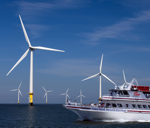By Rochelle March and Serena McIntosh
We waited apprehensively for Mike Tidwell, this week’s NCS speaker, to answer the phone. After 5 long minutes, he finally picked up and explained the reason for his tardiness. That day—at that exact moment—the Maryland General Assembly had been debating the proposal of Maryland’s Governor O’Malley for an Offshore Wind Project. At 12:00 PM, the time the seminar was slated to begin, Mike Tidwell had been “attacked by name” on the House floor. Understandably, the students excused him for his tardiness as he began to tell us about the specifics of Maryland’s offshore wind project.

Mike Tidwell is the Executive Director at the Chesapeake Climate Action Network (CCAN), a nonprofit/grassroots organization based out of Takoma Park, MD, that is committed to combating climate change in the DC-Maryland-Virginia metropolitan area. Tidwell’s interest in alternative energy, and specifically wind power, began in the spring of 2010, following the Deepwater Horizon oil spill in the Gulf of Mexico. Concerned with the US’s reliance on fossil fuels, Tidwell and his colleagues began to think about an alternative vision for offshore energy in Maryland—especially because some of the strongest winds in the world are offshore of Ocean City, Maryland. Mirroring the Cape Wind Project in Nantucket, Massachusetts, the first wind farm of its kind in the United States, CCAN worked with Governor O’ Malley to push forward the MD offshore wind bill, which would establish the foundation for a wind farm in the Atlantic Ocean.
Naturally, we had some questions concerning the logistics of wind farm implementation, as did some callers from the audience:
Project Feasibility?
First off, could the construction of a 400-600 MW wind farm, as the O’Malley Bill suggests, even be possible?

“Of course,” answered Tidwell. “By 2020, 400-600 megawatts can be constructed off the coast of Maryland alone.
These windmills will be interconnected by an offshore smart grid that can collect all the wind-generated power and send it directly to city power lines. In addition, the proposed location is perfect for offshore wind power generation. For example, Maryland’s coast is uniquely shallow for hundreds of miles out, which is perfect terrain for wind turbine installation. The winds will create a constant flow of electricity, while the land below the water provides a solid, dependable foundation. The expected wind farm will neighbor a high-demand area and has the potential to power up to 25-30% of the state’s power load. That’s pretty amazing.
Currently, wind power technology is able to power about 1,000 homes with just one megawatt of power. With just 400 megawatts of wind power generation, the offshore project could potentially power up to 400,000 homes, or about 18% of Maryland’s domiciles.
But, what about the birds?
Wind farms have been notorious for hitting several bird species flying on their migration routes.
“Well,” replied Tidwell, “One of the largest environmental NGOs, the Massachusetts Audubon Society, has actively approved of the project and the Cape Wind Initiative. And if there’s anybody who cares about birds…” It would be those guys. That’s reassuring.
What about hurricanes, and wind threats?
Would turbines be able to survive the increasingly rampant amount of storms hitting the Eastern coast?
“Definitely,” said Tidwell. “Wind farms in Europe have been known to be perfectly fine after enduring 70 mph winds and are manufactured to withstand hurricanes of a Category 3 magnitude.
And how will public opposition be addressed?
And specifically, the NIMBY (not in my backyard) mentality of Marylanders? Wind farm construction is often halted due to public criticism of their unattractive appearance.
Fortunately, Tidwell informed us that NIMBY is generally an issue for on-shore wind farm construction, but not a big deal for offshore wind turbines.

In Maryland alone, there have been 700,000 manufacturing jobs lost since 1990 with no other industry to provide for those lost jobs. However, the construction of wind power could create a massive job market, which is why this bill has garnered support from environmentalists and labor unions alike. If the bill goes through, this could be a great economic and environmental push for the state. In addition, Tidwell informed us that wind energy has become more attractive recently due to growing public concern about unhealthy levels of air and water quality due to overuse of fossil fuels.
Maryland is taking the lead in new wind generation, especially since there are currently zero offshore wind farms in existence in the United States. With national climate policy failing to fulfill expectations and initiate successful energy policy, it is up to the states to make changes on the energy front. Other states in the U.S. can soon, hopefully, look towards Maryland as a model for wind farm development. State by state, and person by person, it may be time to take our health, energy security, and environment into our own legislative hands.
Listen to Mike Tidwell’s discussion on Offshore Wind: Potential and Politics here.
Written by Rochelle March and Serena McIntosh.

Rochelle March is a student at Bard CEP in the Environmental Policy and Bard MBA programs. She is interested in environmental corporate social responsibility and natural capital.
Serena McIntosh is a student at Bard CEP in the MS in Environmental Policy program.
